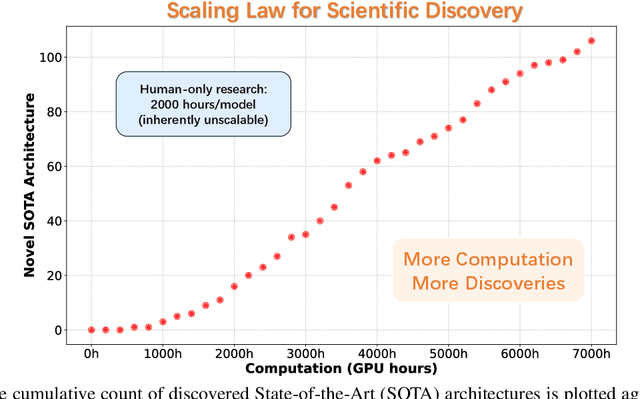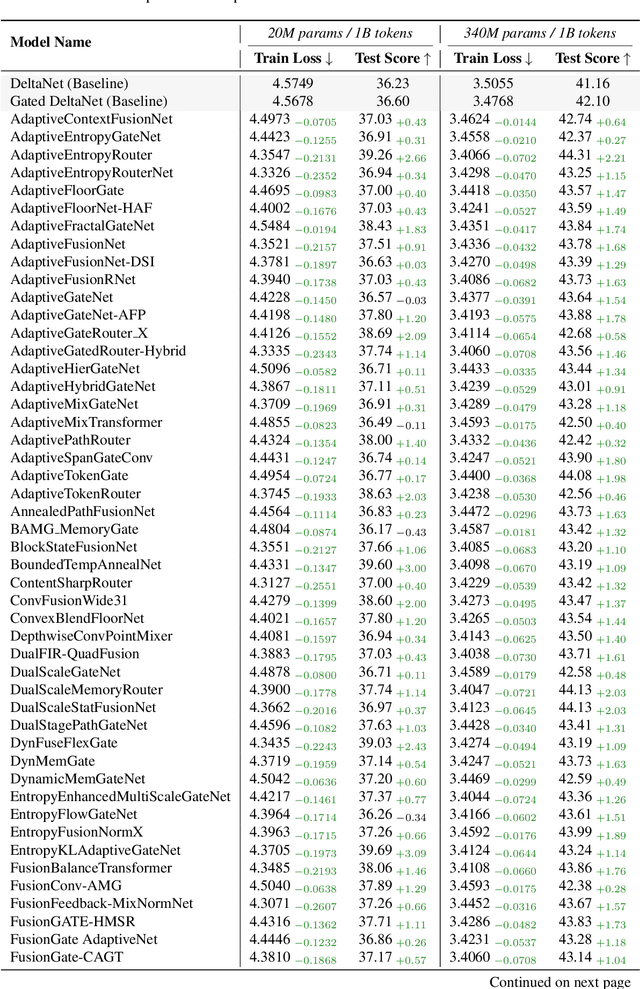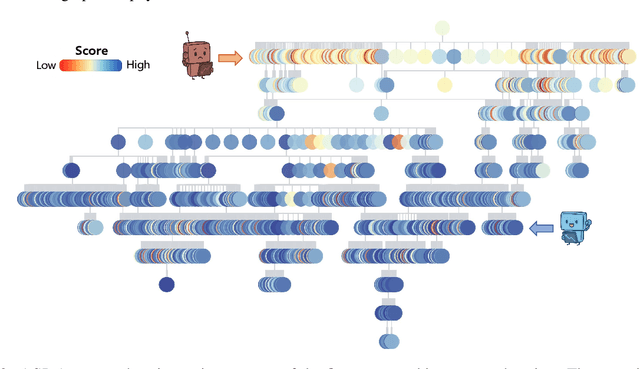Zhen Qin
Group Representational Position Encoding
Dec 08, 2025Abstract:We present GRAPE (Group RepresentAtional Position Encoding), a unified framework for positional encoding based on group actions. GRAPE brings together two families of mechanisms: (i) multiplicative rotations (Multiplicative GRAPE) in $\mathrm{SO}(d)$ and (ii) additive logit biases (Additive GRAPE) arising from unipotent actions in the general linear group $\mathrm{GL}$. In Multiplicative GRAPE, a position $n \in \mathbb{Z}$ (or $t \in \mathbb{R}$) acts as $\mathbf{G}(n)=\exp(n\,ω\,\mathbf{L})$ with a rank-2 skew generator $\mathbf{L} \in \mathbb{R}^{d \times d}$, yielding a relative, compositional, norm-preserving map with a closed-form matrix exponential. RoPE is recovered exactly when the $d/2$ planes are the canonical coordinate pairs with log-uniform spectrum. Learned commuting subspaces and compact non-commuting mixtures strictly extend this geometry to capture cross-subspace feature coupling at $O(d)$ and $O(r d)$ cost per head, respectively. In Additive GRAPE, additive logits arise as rank-1 (or low-rank) unipotent actions, recovering ALiBi and the Forgetting Transformer (FoX) as exact special cases while preserving an exact relative law and streaming cacheability. Altogether, GRAPE supplies a principled design space for positional geometry in long-context models, subsuming RoPE and ALiBi as special cases. Project Page: https://github.com/model-architectures/GRAPE.
Higher-order Linear Attention
Oct 31, 2025Abstract:The quadratic cost of scaled dot-product attention is a central obstacle to scaling autoregressive language models to long contexts. Linear-time attention and State Space Models (SSMs) provide scalable alternatives but are typically restricted to first-order or kernel-based approximations, which can limit expressivity. We introduce Higher-order Linear Attention (HLA), a causal, streaming mechanism that realizes higher interactions via compact prefix sufficient statistics. In the second-order case, HLA maintains a constant-size state and computes per-token outputs in linear time without materializing any $n \times n$ matrices. We give closed-form streaming identities, a strictly causal masked variant using two additional summaries, and a chunk-parallel training scheme based on associative scans that reproduces the activations of a serial recurrence exactly. We further outline extensions to third and higher orders. Collectively, these results position HLA as a principled, scalable building block that combines attention-like, data-dependent mixing with the efficiency of modern recurrent architectures. Project Page: https://github.com/yifanzhang-pro/HLA.
Elucidating the Design Space of Decay in Linear Attention
Sep 05, 2025Abstract:This paper presents a comprehensive investigation into the decay mechanisms inherent in linear complexity sequence models. We systematically delineate the design space of decay mechanisms across four pivotal dimensions: parameterization strategy, which refers to the computational methodology for decay; parameter sharing, which involves the utilization of supplementary parameters for decay computation; decay granularity, comparing scalar versus vector-based decay; and compatibility with relative positional encoding methods, such as Rotary Position Embedding (RoPE). Through an extensive series of experiments conducted on diverse language modeling tasks, we uncovered several critical insights. Firstly, the design of the parameterization strategy for decay requires meticulous consideration. Our findings indicate that effective configurations are typically confined to a specific range of parameters. Secondly, parameter sharing cannot be used arbitrarily, as it may cause decay values to be too large or too small, thereby significantly impacting performance. Thirdly, under identical parameterization strategies, scalar decay generally underperforms compared to its vector-based counterpart. However, in certain scenarios with alternative parameterization strategies, scalar decay may unexpectedly surpass vector decay in efficacy. Lastly, our analysis reveals that RoPE, a commonly employed relative positional encoding method, typically fails to provide tangible benefits to the majority of linear attention mechanisms.
AlphaGo Moment for Model Architecture Discovery
Jul 24, 2025



Abstract:While AI systems demonstrate exponentially improving capabilities, the pace of AI research itself remains linearly bounded by human cognitive capacity, creating an increasingly severe development bottleneck. We present ASI-Arch, the first demonstration of Artificial Superintelligence for AI research (ASI4AI) in the critical domain of neural architecture discovery--a fully autonomous system that shatters this fundamental constraint by enabling AI to conduct its own architectural innovation. Moving beyond traditional Neural Architecture Search (NAS), which is fundamentally limited to exploring human-defined spaces, we introduce a paradigm shift from automated optimization to automated innovation. ASI-Arch can conduct end-to-end scientific research in the domain of architecture discovery, autonomously hypothesizing novel architectural concepts, implementing them as executable code, training and empirically validating their performance through rigorous experimentation and past experience. ASI-Arch conducted 1,773 autonomous experiments over 20,000 GPU hours, culminating in the discovery of 106 innovative, state-of-the-art (SOTA) linear attention architectures. Like AlphaGo's Move 37 that revealed unexpected strategic insights invisible to human players, our AI-discovered architectures demonstrate emergent design principles that systematically surpass human-designed baselines and illuminate previously unknown pathways for architectural innovation. Crucially, we establish the first empirical scaling law for scientific discovery itself--demonstrating that architectural breakthroughs can be scaled computationally, transforming research progress from a human-limited to a computation-scalable process. We provide comprehensive analysis of the emergent design patterns and autonomous research capabilities that enabled these breakthroughs, establishing a blueprint for self-accelerating AI systems.
Autoregressive Image Generation with Linear Complexity: A Spatial-Aware Decay Perspective
Jul 02, 2025Abstract:Autoregressive (AR) models have garnered significant attention in image generation for their ability to effectively capture both local and global structures within visual data. However, prevalent AR models predominantly rely on the transformer architectures, which are beset by quadratic computational complexity concerning input sequence length and substantial memory overhead due to the necessity of maintaining key-value caches. Although linear attention mechanisms have successfully reduced this burden in language models, our initial experiments reveal that they significantly degrade image generation quality because of their inability to capture critical long-range dependencies in visual data. We propose Linear Attention with Spatial-Aware Decay (LASAD), a novel attention mechanism that explicitly preserves genuine 2D spatial relationships within the flattened image sequences by computing position-dependent decay factors based on true 2D spatial location rather than 1D sequence positions. Based on this mechanism, we present LASADGen, an autoregressive image generator that enables selective attention to relevant spatial contexts with linear complexity. Experiments on ImageNet show LASADGen achieves state-of-the-art image generation performance and computational efficiency, bridging the gap between linear attention's efficiency and spatial understanding needed for high-quality generation.
On the Convergence of Gradient Descent on Learning Transformers with Residual Connections
Jun 05, 2025Abstract:Transformer models have emerged as fundamental tools across various scientific and engineering disciplines, owing to their outstanding performance in diverse applications. Despite this empirical success, the theoretical foundations of Transformers remain relatively underdeveloped, particularly in understanding their training dynamics. Existing research predominantly examines isolated components--such as self-attention mechanisms and feedforward networks--without thoroughly investigating the interdependencies between these components, especially when residual connections are present. In this paper, we aim to bridge this gap by analyzing the convergence behavior of a structurally complete yet single-layer Transformer, comprising self-attention, a feedforward network, and residual connections. We demonstrate that, under appropriate initialization, gradient descent exhibits a linear convergence rate, where the convergence speed is determined by the minimum and maximum singular values of the output matrix from the attention layer. Moreover, our analysis reveals that residual connections serve to ameliorate the ill-conditioning of this output matrix, an issue stemming from the low-rank structure imposed by the softmax operation, thereby promoting enhanced optimization stability. We also extend our theoretical findings to a multi-layer Transformer architecture, confirming the linear convergence rate of gradient descent under suitable initialization. Empirical results corroborate our theoretical insights, illustrating the beneficial role of residual connections in promoting convergence stability.
Hybrid Latent Reasoning via Reinforcement Learning
May 24, 2025Abstract:Recent advances in large language models (LLMs) have introduced latent reasoning as a promising alternative to autoregressive reasoning. By performing internal computation with hidden states from previous steps, latent reasoning benefit from more informative features rather than sampling a discrete chain-of-thought (CoT) path. Yet latent reasoning approaches are often incompatible with LLMs, as their continuous paradigm conflicts with the discrete nature of autoregressive generation. Moreover, these methods rely on CoT traces for training and thus fail to exploit the inherent reasoning patterns of LLMs. In this work, we explore latent reasoning by leveraging the intrinsic capabilities of LLMs via reinforcement learning (RL). To this end, we introduce hybrid reasoning policy optimization (HRPO), an RL-based hybrid latent reasoning approach that (1) integrates prior hidden states into sampled tokens with a learnable gating mechanism, and (2) initializes training with predominantly token embeddings while progressively incorporating more hidden features. This design maintains LLMs' generative capabilities and incentivizes hybrid reasoning using both discrete and continuous representations. In addition, the hybrid HRPO introduces stochasticity into latent reasoning via token sampling, thereby enabling RL-based optimization without requiring CoT trajectories. Extensive evaluations across diverse benchmarks show that HRPO outperforms prior methods in both knowledge- and reasoning-intensive tasks. Furthermore, HRPO-trained LLMs remain interpretable and exhibit intriguing behaviors like cross-lingual patterns and shorter completion lengths, highlighting the potential of our RL-based approach and offer insights for future work in latent reasoning.
EVADE: Multimodal Benchmark for Evasive Content Detection in E-Commerce Applications
May 23, 2025Abstract:E-commerce platforms increasingly rely on Large Language Models (LLMs) and Vision-Language Models (VLMs) to detect illicit or misleading product content. However, these models remain vulnerable to evasive content: inputs (text or images) that superficially comply with platform policies while covertly conveying prohibited claims. Unlike traditional adversarial attacks that induce overt failures, evasive content exploits ambiguity and context, making it far harder to detect. Existing robustness benchmarks provide little guidance for this demanding, real-world challenge. We introduce EVADE, the first expert-curated, Chinese, multimodal benchmark specifically designed to evaluate foundation models on evasive content detection in e-commerce. The dataset contains 2,833 annotated text samples and 13,961 images spanning six demanding product categories, including body shaping, height growth, and health supplements. Two complementary tasks assess distinct capabilities: Single-Violation, which probes fine-grained reasoning under short prompts, and All-in-One, which tests long-context reasoning by merging overlapping policy rules into unified instructions. Notably, the All-in-One setting significantly narrows the performance gap between partial and full-match accuracy, suggesting that clearer rule definitions improve alignment between human and model judgment. We benchmark 26 mainstream LLMs and VLMs and observe substantial performance gaps: even state-of-the-art models frequently misclassify evasive samples. By releasing EVADE and strong baselines, we provide the first rigorous standard for evaluating evasive-content detection, expose fundamental limitations in current multimodal reasoning, and lay the groundwork for safer and more transparent content moderation systems in e-commerce. The dataset is publicly available at https://huggingface.co/datasets/koenshen/EVADE-Bench.
Accelerate TarFlow Sampling with GS-Jacobi Iteration
May 19, 2025Abstract:Image generation models have achieved widespread applications. As an instance, the TarFlow model combines the transformer architecture with Normalizing Flow models, achieving state-of-the-art results on multiple benchmarks. However, due to the causal form of attention requiring sequential computation, TarFlow's sampling process is extremely slow. In this paper, we demonstrate that through a series of optimization strategies, TarFlow sampling can be greatly accelerated by using the Gauss-Seidel-Jacobi (abbreviated as GS-Jacobi) iteration method. Specifically, we find that blocks in the TarFlow model have varying importance: a small number of blocks play a major role in image generation tasks, while other blocks contribute relatively little; some blocks are sensitive to initial values and prone to numerical overflow, while others are relatively robust. Based on these two characteristics, we propose the Convergence Ranking Metric (CRM) and the Initial Guessing Metric (IGM): CRM is used to identify whether a TarFlow block is "simple" (converges in few iterations) or "tough" (requires more iterations); IGM is used to evaluate whether the initial value of the iteration is good. Experiments on four TarFlow models demonstrate that GS-Jacobi sampling can significantly enhance sampling efficiency while maintaining the quality of generated images (measured by FID), achieving speed-ups of 4.53x in Img128cond, 5.32x in AFHQ, 2.96x in Img64uncond, and 2.51x in Img64cond without degrading FID scores or sample quality. Code and checkpoints are accessible on https://github.com/encoreus/GS-Jacobi_for_TarFlow
Optimizing Compound Retrieval Systems
Apr 16, 2025



Abstract:Modern retrieval systems do not rely on a single ranking model to construct their rankings. Instead, they generally take a cascading approach where a sequence of ranking models are applied in multiple re-ranking stages. Thereby, they balance the quality of the top-K ranking with computational costs by limiting the number of documents each model re-ranks. However, the cascading approach is not the only way models can interact to form a retrieval system. We propose the concept of compound retrieval systems as a broader class of retrieval systems that apply multiple prediction models. This encapsulates cascading models but also allows other types of interactions than top-K re-ranking. In particular, we enable interactions with large language models (LLMs) which can provide relative relevance comparisons. We focus on the optimization of compound retrieval system design which uniquely involves learning where to apply the component models and how to aggregate their predictions into a final ranking. This work shows how our compound approach can combine the classic BM25 retrieval model with state-of-the-art (pairwise) LLM relevance predictions, while optimizing a given ranking metric and efficiency target. Our experimental results show optimized compound retrieval systems provide better trade-offs between effectiveness and efficiency than cascading approaches, even when applied in a self-supervised manner. With the introduction of compound retrieval systems, we hope to inspire the information retrieval field to more out-of-the-box thinking on how prediction models can interact to form rankings.
 Add to Chrome
Add to Chrome Add to Firefox
Add to Firefox Add to Edge
Add to Edge